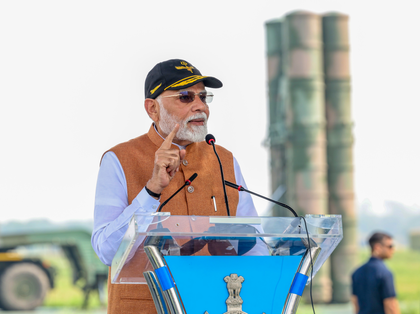US can learn from Operation Sindoor success, 'Make in India' initiative: Top urban warfare experts
By IANS | Updated: July 31, 2025 17:34 IST2025-07-31T17:28:37+5:302025-07-31T17:34:49+5:30
Washington, July 31 Spotlighting the overwhelming success of India's Operation Sindoor, top US defence experts have suggested that ...

US can learn from Operation Sindoor success, 'Make in India' initiative: Top urban warfare experts
Washington, July 31 Spotlighting the overwhelming success of India's Operation Sindoor, top US defence experts have suggested that Washington can learn from New Delhi's success and model some of its changes in defence manufacturing process for its own needs.
In their detailed analysis for the Small Wars Journal (SWJ) - titled 'India's Wake-Up Call: Why US Defense Reform Must Match the Speed of Modern War' - leading American defence analyst John Spencer and Vincent Viola, the former Chairman and CEO of the New York Mercantile Exchange who has also served in the 101st Airborne Division, called India "a master of the physics of lethality", from which the United States can learn a lot.
In their analysis, the duo stated that the United States is in urgent need of a full-scale overhaul in defence reforms. The wars of today, and the even more brutal ones looming on the horizon, they mentioned, will not be won by the slow, the bloated, or the bureaucratically constrained but by those who can think faster, build faster, and fight smarter — and above all, by those who master the physics of lethality required on the modern battlefield.
"India just proved what that looks like," they wrote.
Spencer, Chair of urban warfare studies at the Modern War Institute, and Viola then cite India as a "compelling model", tracing how the 'Make in India' initiative launched by Prime Minister Narendra Modi in 2014 became a game-changer in reforming India's defence sector with the massive investment paying off a decade later during the Operation Sindoor.
"Operation Sindoor was more than a swift and precise military response to another cross-border terrorist attack. It marked a strategic inflection point. In just four days, India used domestically developed systems to strike hardened targets across the border with precision, speed, and overwhelming effect. No US systems. No foreign supply lines. Just BrahMos missiles, Akashteer air defense units, and loitering munitions designed or assembled at home," the experts wrote in their SWJ piece.
"India's overwhelming success demonstrated something more enduring than airpower. It validated a national defence doctrine built around efficient domestic industrial strength. And most significantly, it delivered a clear message to its strategic rival. Pakistan — a Chinese proxy by armament, alignment, doctrine — was completely outmatched. Its Chinese-made air defence systems could not stop, detect, or deter India's precision strikes. In Sindoor, India didn't just win. It demonstrated overwhelming military superiority against a Chinese-backed adversary," they added.
Highlighting the success of BrahMos supersonic cruise missiles, AI-integrated air defence control Akashteer system, drones and long-range autonomous loitering munitions during Operation Sindoor, the analysts reckoned that these systems were not boutique prototypes but were deployed, tested, and validated in a real war.
In the skies over Pakistan, India didn't just dominate but redefined regional deterrence, the duo stated.
"India has already moved from 30 per cent to 65 per cent domestic sourcing in defence capital procurement, with a goal of 90 per cent by the decade's end. It increased capital outlays for domestic production from $6 billion in 2019-2020 to nearly $20 billion in 2023-24. It allowed up to 74 per cent FDI in defence, bringing in foreign partners while building indigenous capacity. India didn't just talk about reform. It executed it. And it won," they wrote.
Urging the US to not only revive its defence industrial power but also master the physics of lethality at scale, speed, and sustainability, the experts called for establishing permanent, deployable learning teams — designed not to sift lessons from media reports, but to gather them directly from the ground.
"These teams must operate forward, embedded where history is unfolding: in urban combat zones, in drone labs, in dispersed logistics hubs. From Ukraine to India, battlefield truths are being written in real time. The US must capture them not passively, but through deliberate collection, analysis, and integration into our own systems — with one goal in mind: making the US defence ecosystem the most efficient, adaptable, and dominant in the world," the top urban warfare experts reckoned.
Disclaimer: This post has been auto-published from an agency feed without any modifications to the text and has not been reviewed by an editor
Open in app